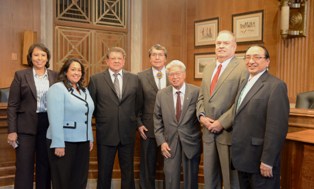WASHINGTON D.C. –
U.S. Senator Daniel K. Akaka (D-Hawaii), Chairman of the Senate Committee on Indian Affairs, held an oversight hearing today to identify barriers and successes in developing vast traditional and renewable energy resources on Native lands.
“Native lands hold great potential for energy development. Collectively, tribal nations are the third-largest owners of mineral resources in the United States,” said Chairman Akaka. “Native lands are also geographically situated to become great producers of renewable energy resources such as wind, solar, and biomass.”
 “To date, more than two million acres of Indian lands have already been leased for oil and natural gas development. These lands account for about 10 percent of the oil and natural gas production from federally regulated onshore acreage,” said Jodi Gillette, Deputy Assistant Secretary for Indian Affairs at the Department of the Interior. “We estimate that an additional 15 million acres of undeveloped energy and mineral resources may exist on individual Indian and tribal lands, which if fully developed could result in billions of dollars in revenue.”
“To date, more than two million acres of Indian lands have already been leased for oil and natural gas development. These lands account for about 10 percent of the oil and natural gas production from federally regulated onshore acreage,” said Jodi Gillette, Deputy Assistant Secretary for Indian Affairs at the Department of the Interior. “We estimate that an additional 15 million acres of undeveloped energy and mineral resources may exist on individual Indian and tribal lands, which if fully developed could result in billions of dollars in revenue.”
“Enabling Native communities to develop their energy resources helps tribes build their economies and provide goods and services for their people. It also creates jobs in rural communities throughout the United States for both Natives and non-Natives alike while reducing dependency on foreign energy sources,” said Chairman Akaka.
The Committee explored the connection between energy production, job creation, and economic development.
“For every energy job created, three subsidiary jobs are created,” said Rex Lee Jim, Vice President of Navajo Nation.
“What comes with the development of an oil refinery? Jobs, jobs, and more jobs,” said Thomas “Stoney” Anketell, Tribal Executive Board Member, Assiniboine and Sioux Tribes of the Fort Peck Reservation. “With a [refinery], our tribe’s current 65 percent unemployment rate would be taken down to nothing.”
“Currently eighty cents of every dollar leaves the reservation but energy development would help keep revenue on the reservation. If more money stays on reservation, then more can go to tribal businesses,” said Rodney Bordeaux, President of the Rosebud Sioux Tribe.
Witnesses also discussed current energy development roadblocks.
“Key obstacles to commercial-scale energy development in Indian Country include: the cost to build projects and the financing and funding options available for construction projects; access to transmission and the grid, and distribution of the electricity generated from projects; and securing buyers who are willing to purchase renewable energy at the cost to produce the energy,” said Tracey A. LeBeau, Director of the Office of Indian Energy Policy and Programs at the U.S. Department of Energy.
“Despite our best efforts over the past decades to develop our natural resources in an economically and environmentally sustainable manner, the difficulty of tapping these reserves, along with the challenges of dealing with multiple jurisdictions, have made it difficult for our Tribal government to make a significant dent in the unemployment and poverty that still plague our Reservation,” said Anketell.
Witnesses testified that jurisdictional matters were further complicated by the 2009 Carcieri v. Salazar Supreme Court decision, which created two classes of tribes: those that can have land in trust and those that cannot.
“The Carcieri decision is a barrier to economic development in Indian Country,” said Gillette. “The ability to take land into trust is critical to creating an environment that is conducive to economic development and attracting investment in Indian communities. This includes energy planning and improving energy development capacity.”
As the hearing drew to a close, witnesses exchanged views regarding how to remove barriers to energy production on Native lands.
“With specific attention to the development of federal energy policy dedicated to trust land areas, the potential of Native lands in playing a significant role in our nation’s energy future becomes possible. Access to capital, dedicated technical assistance resources and infrastructure investments, along with streamlined land use policies, are areas that this committee can champion to create a new reality in energy development,” said Michelle Kauhane, Deputy Director of the Department of Hawaiian Home Lands.
“Helping Native communities develop their energy resources means a better quality of life for Native people and will provide much needed jobs to Americans living in rural and under-employed communities,” said Chairman Akaka. “I look forward to continuing to work together with my colleagues on these issues so that we may implement policies that improve energy development on Native lands.”
More information and an archived webcast is available on the committee’s website: indian.senate.gov
-END-
Contact: Emily Deimel
Contact Phone: 202) 224-2251
Contact E-mail: emily_deimel@indian.senate.gov
